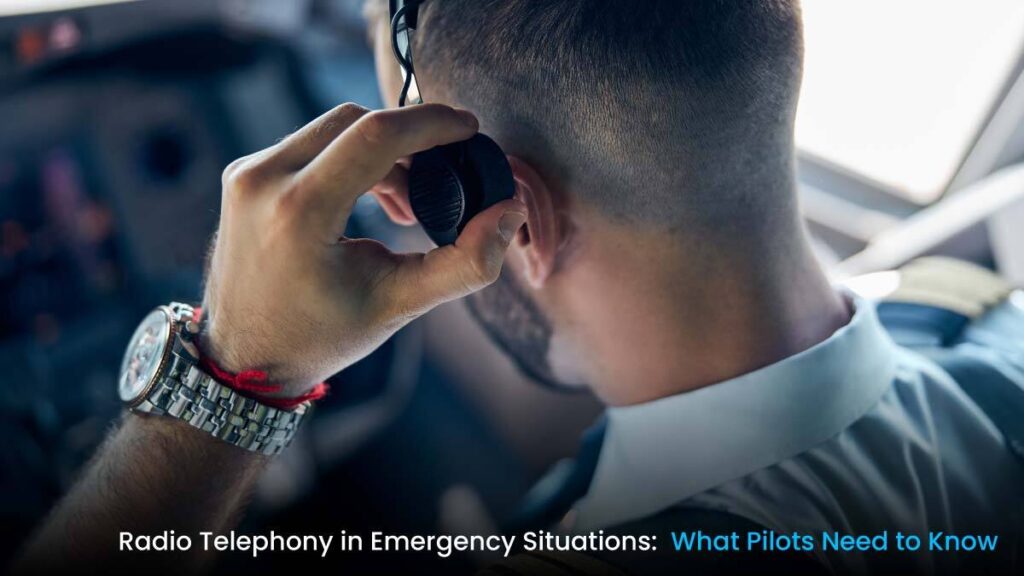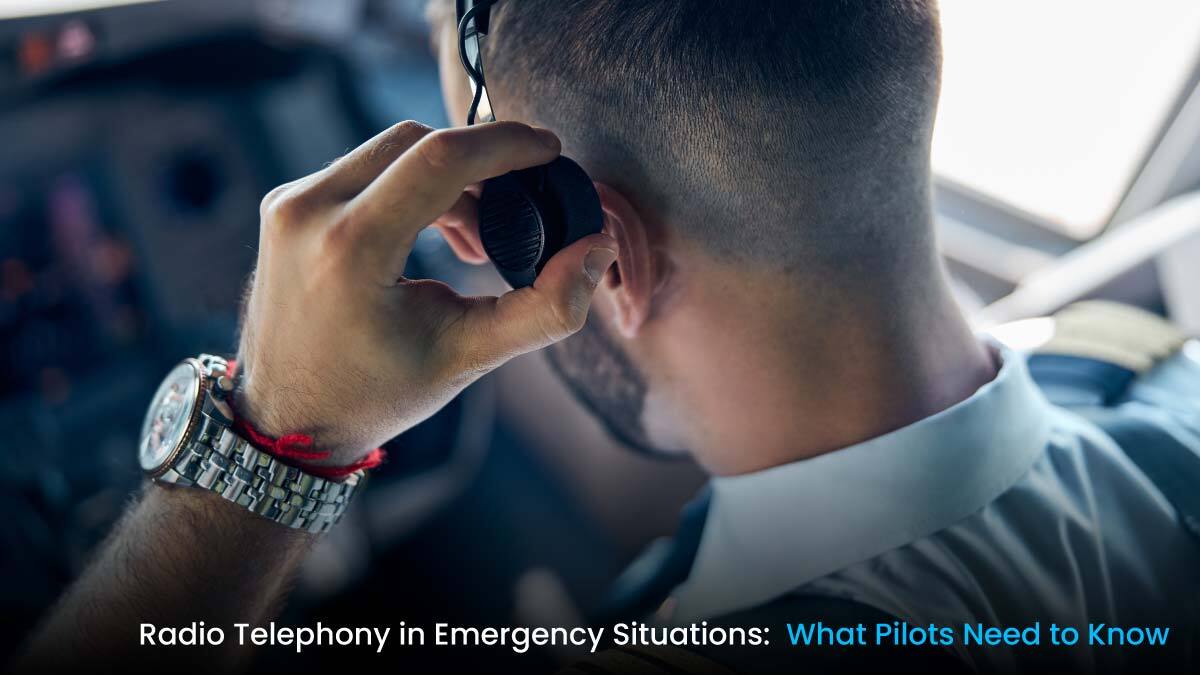
The pilot’s voice might be their most vital asset in an emergency. When something goes wrong in flight, clear and calm communication can make a major impact. Radio telephony is more than simply a means of communicating routinely; it may be a lifeline in emergencies. Whether there is a mechanical issue, a medical emergency, or a loss of navigation, learning how to utilise RT properly will ensure everyone’s safety on board.
The Role of Radio Telephony in Emergencies
In aviation, emergencies call for swift judgment and accurate performance. Pilots may prepare for many scenarios through training and experience, but communicating with air traffic control (ATC) is still an essential skill. In times of stress, a good message can provide needed relief. It is important to ensure ATC receives essential information quickly, and that the ATC understands the nature of the problem and offers the right level of support.
Aviation emergencies demand quick consideration and accurate execution. Pilots depend on communication with air traffic control (ATC), even as training and experience prepare them for the normal or the improbable. In challenging times, a clear message framework is invaluable. And in that information, the pilots have to communicate several key details quickly, so that ATC can get a picture of what just happened and respond with the appropriate help.
Making a Mayday call: When and How
A Mayday call is the most serious distress call one can make in aviation. Pilots should do so only in dire situations where their lives are in danger, including failure of an engine, fire or serious medical emergencies. The call follows a specific structure:
- Say “Mayday” three times to signal an immediate emergency.
- Identify the aircraft with its call sign.
- State the nature of the emergency (e.g., engine failure, fire, medical issue).
- Provide the aircraft’s position, altitude, and heading.
- Share the number of people on board and any other relevant information.
- Wait for ATC’s response and follow instructions carefully.
Handling an Emergency Landing with RT
Sometimes, an emergency may require an immediate return to the ground. In such cases, pilots must inform ATC promptly and clearly. Unlike a Mayday, a PAN-PAN call is used for urgent but non-life-threatening situations. If an emergency landing is needed, the pilot should:
- Declare the emergency with either a Mayday or PAN-PAN call.
- Provide details about the issue and intended landing site.
- Follow ATC instructions and keep them updated on any changes.
- Focus on a safe and controlled descent.
- Ensure passengers are prepared for the landing by following standard emergency procedures.
- If landing at a remote location, request assistance and medical support if needed.
What If Radio Communication Fails?
Losing contact with ATC can be unsettling, but there are standard procedures to follow:
- First, check all radio settings, including volume and frequency.
- Try an alternative frequency or the emergency channel (121.5 MHz).
- Use transponder code 7600 to signal a radio failure.
- Follow standard navigation and approach procedures.
- Watch for light signals from the control tower if landing at an airport.
- If communication remains impossible, follow the last known ATC instructions and proceed with caution.
Managing a Medical Emergency Over RT
Medical emergencies in flight demand swift action. If a passenger or crew member falls seriously ill, the pilot should:
- Declare an emergency with a PAN-PAN or Mayday call, depending on severity.
- Describe the medical condition briefly but clearly.
- Request medical assistance on landing if needed.
- Follow ATC’s advice, which may include diverting to the nearest airport.
- If a doctor or medically trained person is onboard, involve them immediately.
- Ask ATC for guidance on available medical facilities at the landing airport.
The Importance of Pilot Training for Emergency Communication
Effective emergency communication doesn’t happen by chance—it requires practice. Many aviation schools offer specialised pilot training in RT for emergency situations. These courses focus on:
- Standard phraseology and procedures.
- Handling high-pressure communications.
- Practising real-life emergency scenarios in simulators.
- Improving clarity and confidence over the radio.
- Adapting communication techniques for different emergency scenarios.
- Learning about new technology and automated communication support systems.
The Role of ATC in Emergency Responses
Air traffic controllers play a crucial role in guiding pilots through emergencies. They provide alternative routing, prioritise landing clearance, and coordinate emergency services on the ground. Pilots must trust ATC instructions and maintain effective two-way communication. ATC professionals are trained to handle distress situations and can offer vital support in moments of crisis.
The Future of Emergency Radio Telephony
Technology continues to improve communication systems in aviation. Advancements such as digital data links, satellite-based communication, and AI-assisted RT procedures help reduce misunderstandings and improve response times. As technology evolves, pilots must stay updated with the latest tools and ensure they remain proficient in traditional and future RT techniques.
Conclusion
When faced with an emergency, a pilot’s ability to communicate effectively can save lives. Understanding how to use radio telephony in critical situations is a skill every pilot must master. Through proper pilot training, structured calls like a Mayday call, and knowing how to manage an emergency landing, pilots can ensure they respond to emergencies with clarity and confidence. Learning and practising these skills is not just a regulatory requirement—it is a fundamental part of aviation safety.
Advancements in technology continue to shape emergency communication. However, the human factor remains crucial. Pilots must stay calm, focused, and well-prepared to use RT effectively in emergencies. Ongoing training and awareness will help aviation professionals maintain the highest levels of safety and efficiency in all situations.
FAQs
Q: Why is RT crucial in emergency situations?
A: RT ensures that pilots can get immediate help from ATC and other aircraft. It helps coordinate responses, preventing confusion and delays.
Q: How should a pilot structure a Mayday call?
A: Start with “Mayday” three times, then state the aircraft call sign, nature of emergency, position, altitude, and number of people onboard.
Q: What should a pilot do in case of radio communication failure?
A: Check settings, switch frequencies, use the emergency channel, set transponder code 7600, and follow pre-set navigation and landing protocols.
Q: How should pilots handle an onboard medical emergency over RT?
A: Declare the emergency, describe the issue, request medical assistance, and follow ATC instructions for a possible diversion.
Q: Are there training programmes for RT in emergencies?
A: Yes, many aviation schools offer specialised courses focusing on emergency communication techniques and procedures.

